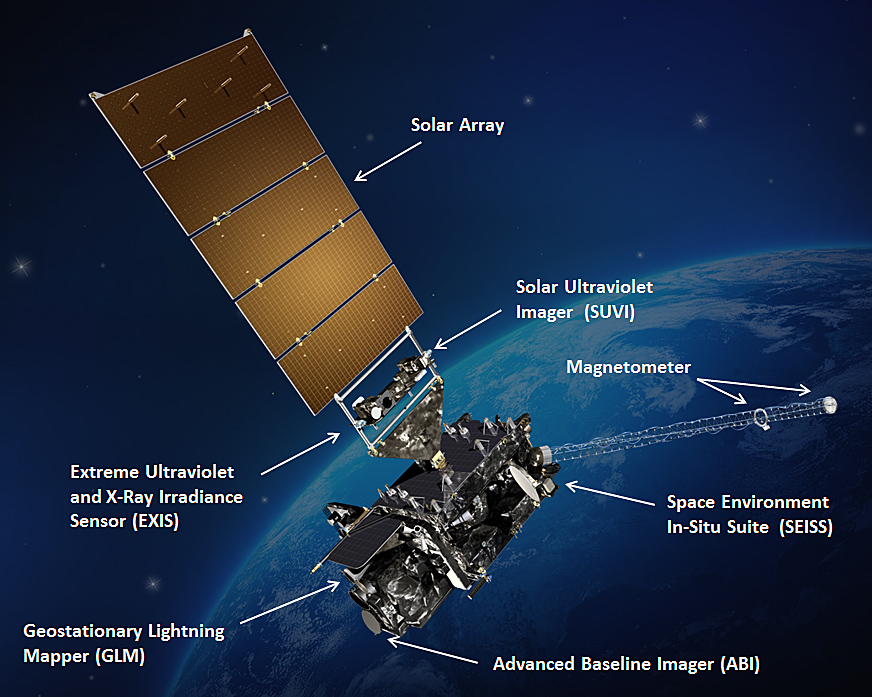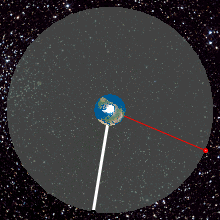|
GOES 10
GOES-10, known as GOES-K before becoming operational, was an American weather satellite, which formed part of the US National Oceanic and Atmospheric Administration's Geostationary Operational Environmental Satellite system. It was launched in 1997, and after completing operations as part of the main GOES system, it was kept online as a backup spacecraft until December 2009, providing coverage of South America as GOES-SOUTH, and being used to assist with hurricane predictions for North America. It was retired and maneuvered to a graveyard orbit on 1 December 2009. Launch GOES-K was launched aboard an International Launch Services Atlas I rocket, flying from Launch Complex 36B at the Cape Canaveral Air Force Station. The launch occurred at 05:49 GMT on 25 April. Its launch was the final flight of the Atlas I rocket, which was retired in favour of the modernised Atlas II. At launch, the satellite had a mass of , and an expected operational lifespan of five years. It was built by ... [...More Info...] [...Related Items...] OR: [Wikipedia] [Google] [Baidu] |
Weather Satellite
A weather satellite or meteorological satellite is a type of Earth observation satellite that is primarily used to monitor the weather and climate of the Earth. Satellites are mainly of two types: polar orbiting (covering the entire Earth asynchronously) or geostationary (hovering over the same spot on the equator). While primarily used to detect the development and movement of storm systems and other cloud patterns, meteorological satellites can also detect other phenomena such as city lights, fires, effects of pollution, auroras, sand and dust storms, snow cover, ice mapping, boundaries of ocean currents, and energy flows. Other types of environmental information are collected using weather satellites. Weather satellite images helped in monitoring the volcanic ash cloud from Mount St. Helens and activity from other volcanoes such as Mount Etna. Smoke from fires in the western United States such as Colorado and Utah have also been monitored. El Niño and its effects on wea ... [...More Info...] [...Related Items...] OR: [Wikipedia] [Google] [Baidu] |
Geostationary Orbit
A geostationary orbit, also referred to as a geosynchronous equatorial orbit''Geostationary orbit'' and ''Geosynchronous (equatorial) orbit'' are used somewhat interchangeably in sources. (GEO), is a circular orbit, circular geosynchronous orbit in altitude above Earth's equator, in radius from Earth's center, and following the retrograde and prograde motion, direction of Earth's rotation. An object in such an orbit has an orbital period equal to Earth's rotational period, one sidereal time, sidereal day, and so to ground observers it appears motionless, in a fixed position in the sky. The concept of a geostationary orbit was popularised by the science fiction writer Arthur C. Clarke in the 1940s as a way to revolutionise telecommunications, and the first satellite to be placed in this kind of orbit was launched in 1963. Communications satellites are often placed in a geostationary orbit so that Earth-based satellite dish, satellite antennas do not have to rotate to track t ... [...More Info...] [...Related Items...] OR: [Wikipedia] [Google] [Baidu] |
Satellites Using The SSL 1300 Bus
A satellite or an artificial satellite is an object, typically a spacecraft, placed into orbit around a celestial body. They have a variety of uses, including communication relay, weather forecasting, navigation ( GPS), broadcasting, scientific research, and Earth observation. Additional military uses are reconnaissance, early warning, signals intelligence and, potentially, weapon delivery. Other satellites include the final rocket stages that place satellites in orbit and formerly useful satellites that later become defunct. Except for passive satellites, most satellites have an electricity generation system for equipment on board, such as solar panels or radioisotope thermoelectric generators (RTGs). Most satellites also have a method of communication to ground stations, called transponders. Many satellites use a standardized bus to save cost and work, the most popular of which are small CubeSats. Similar satellites can work together as groups, forming constellations. Bec ... [...More Info...] [...Related Items...] OR: [Wikipedia] [Google] [Baidu] |
2009 In Spaceflight
Several significant events in spaceflight occurred in 2009, including Iran conducting its first indigenous orbital launch, the first Switzerland, Swiss satellite being launched and New Zealand launching its first sounding rocket. The H-IIB and Naro-1 rockets conducted maiden flights, whilst the Tsyklon-3, Falcon 1 and Ariane 5, Ariane 5GS were retired from service. The permanent crew of the International Space Station increased from three to six in May, and in the last few months of the year, Japan's first resupply mission to the outpost, HTV-1, was conducted successfully. Overview The internationally accepted definition of a spaceflight is any flight which crosses the Kármán line, 100 kilometres above sea level. The first spaceflight launch of the year was that of a Delta IV Heavy, carrying the USA-202 ELINT satellite, which launched from Cape Canaveral Air Force Station at 02:47 GMT on 18 January. This was also the first orbital launch of the year. On 2 February, Ira ... [...More Info...] [...Related Items...] OR: [Wikipedia] [Google] [Baidu] |
Spacecraft Launched In 1997
A spacecraft is a vehicle that is designed to fly and operate in outer space. Spacecraft are used for a variety of purposes, including communications, Earth observation, meteorology, navigation, space colonization, planetary exploration, and transportation of humans and cargo. All spacecraft except single-stage-to-orbit vehicles cannot get into space on their own, and require a launch vehicle (carrier rocket). On a sub-orbital spaceflight, a space vehicle enters space and then returns to the surface without having gained sufficient energy or velocity to make a full Earth orbit. For orbital spaceflights, spacecraft enter closed orbits around the Earth or around other celestial bodies. Spacecraft used for human spaceflight carry people on board as crew or passengers from start or on orbit (space stations) only, whereas those used for robotic space missions operate either autonomously or telerobotically. Robotic spacecraft used to support scientific research are space probes ... [...More Info...] [...Related Items...] OR: [Wikipedia] [Google] [Baidu] |
List Of GOES Satellites ...
This is a list of Geostationary Operational Environmental Satellites. GOES spacecraft are operated by the United States National Oceanic and Atmospheric Administration, with NASA responsible for research and development, and later procurement of spacecraft. Imagery File:First image from GOES Spac0041.jpg, SMS-derived File:Img-1989-09-19-18-GOE-7-IR.jpg, First-generation File:BW Goes8vis1big.png, Second-generation File:BW 060622_goes13_medium.gif, Third-generation File:GOES 4th Generation full disk imagery.png, Fourth-generation File:GOES-18 full disk GeoColor image from May 5, 2022.png, Fourth-generation Satellites References {{spaceflight lists and timelines * GOES The Geostationary Operational Environmental Satellite (GOES), operated by the United States' National Oceanic and Atmospheric Administration (NOAA)'s National Environmental Satellite, Data, and Information Service division, supports weather fo ... [...More Info...] [...Related Items...] OR: [Wikipedia] [Google] [Baidu] |
1997 In Spaceflight
This article outlines notable events occurring in 1997 in spaceflight, including major launches and EVAs. Cassini–Huygens launch Orbital launches , colspan="8", January , - , colspan="8", February , - , colspan="8", March , - , colspan="8", April , - , colspan="8", May , - , colspan="8", June , - , colspan="8", July , - , colspan="8", August , - , colspan="8", September , - , colspan="8", October , - , colspan="8", November , - , colspan="8", December , - Suborbital launches , colspan=8, January , - , colspan=8, February , - , colspan=8, March , - , colspan=8, April , - , colspan=8, May , - , colspan=8, June , - , colspan=8, July , - , colspan=8, August , - , colspan=8, September , - , colspan=8, October , - , cols ... [...More Info...] [...Related Items...] OR: [Wikipedia] [Google] [Baidu] |
GOES 7
GOES-7, known as GOES-H before becoming operational, is an American satellite. It was originally built as a weather satellite, and formed part of the US National Oceanic and Atmospheric Administration's Geostationary Operational Environmental Satellite system. Originally built as a ground spare, GOES-H was launched in 1987 due to delays with the next series of satellites. It was operated by NOAA until 1999, before being leased to Peacesat, who use it as a communications satellite. As of 2009, it was operational over the Pacific Ocean, providing communications for the Pacific Islands. On April 12, 2012, the spacecraft was finally decommissioned and moved to a graveyard orbit. Launch GOES-H was launched aboard a McDonnell Douglas Delta 3914 rocket, flying from Launch Complex 17A at the Cape Canaveral Air Force Station. The launch occurred at 23:05 GMT on 26 February 1987. The launch had originally been scheduled for late 1986, but was delayed after GOES-G failed to achieve orbit. ... [...More Info...] [...Related Items...] OR: [Wikipedia] [Google] [Baidu] |
GOES 12
GOES-12, known as GOES-M before becoming operational, is an American weather satellite, which is part of the US National Oceanic and Atmospheric Administration's Geostationary Operational Environmental Satellite system. It was launched on July 23, 2001, and spent its first 21 months in space as an on-orbit spare. From April 2003, the satellite took over the GOES-East position, providing coverage of the eastern half of the continental United States. In April 2010, GOES-East operations were taken over by GOES-13, and GOES-12 transitioned to the GOES-South location to devote time to South American imagery. It remained at this post until it was decommissioned on August 16, 2013 and subsequently boosted to a graveyard orbit. Launch GOES-M was launched aboard an International Launch Services Atlas IIA rocket, flying from Space Launch Complex 36A at the Cape Canaveral Air Force Station. The launch occurred at 07:23 GMT on 23 July 2001, having previously been delayed eight days; seven ... [...More Info...] [...Related Items...] OR: [Wikipedia] [Google] [Baidu] |
GOES 13
EWS-G1 (Electro-optical Infrared Weather System Geostationary) is a weather satellite of the U.S. Space Force, formerly GOES-13 (also known as GOES-N before becoming operational) and part of the National Oceanic and Atmospheric Administration's Geostationary Operational Environmental Satellite system. On 14 April 2010, GOES-13 became the operational weather satellite for GOES-East. It was replaced by GOES-16 on 18 December 2017 and on 8 January 2018 its instruments were shut off and it began its three-week drift to an on-orbit storage location at 60.0° West longitude, arriving on 31 January 2018. It remained there as a backup satellite in case one of the operational GOES satellites had a problem until early July 2019, when it started to drift westward and was being transferred to the U.S. Air Force, and then the U.S. Space Force. GOES-13 arrived at 61.5° East longitude in mid-February 2020. The satellite was renamed EWS-G1 and became fully operational over the Indian Ocean ... [...More Info...] [...Related Items...] OR: [Wikipedia] [Google] [Baidu] |
GOES 11
GOES-11, known as GOES-L before becoming operational, is an American weather satellite, which is part of the US National Oceanic and Atmospheric Administration's Geostationary Operational Environmental Satellite system. It was launched in 2000, and operated at the GOES-WEST position, providing coverage of the west coast of the United States, until December 6, 2011. Launch GOES-L was launched aboard an International Launch Services Atlas IIA rocket, flying from Space Launch Complex 36A at the Cape Canaveral Air Force Station. The launch occurred at 07:07 UTC on 3 May. The launch was originally scheduled for 15 March 1999, however it was delayed to allow the Eutelsat W3 satellite to be launched first. Following this, it was rescheduled for 15 May. On 30 April, the Centaur upper stage of a Titan IV(401)B failed during the launch of USA-143. Since a version of the Centaur was also used on the Atlas II, the launch of GOES-L was delayed a week to ensure that the same problem would ... [...More Info...] [...Related Items...] OR: [Wikipedia] [Google] [Baidu] |








